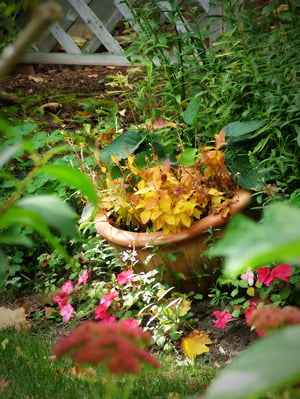It’s a tradition that transcends time and place: the Japanese tea ceremony marked by a slow and graceful ritual of water pouring and contemplation. Building a Japanese teahouse shed can give you a taste of Asia in addition to an attractive place to stow lawn and garden supplies if you’re ready to commit a little sweat equity to the construction. Use the real thing as your inspiration: page through books on Japanese structures to learn how the natural elements of wind, fire, air and water influence the culture and get then to work, inspired by the graceful lifestyle that makes Japan so unique. Don’t forget to celebrate the completion of your shed by toasting your hard work with a cup of tea before you stow those rakes and the weed whacker.
1. Select a prime location in your yard. Sketch your vision of a Japanese teahouse shed, if you’re not using a blueprint, by searching library books and choosing a photo for reference. Contact your municipal government to find out if the project requires a building permit. If the answer is yes, make application and pay the building permit fee.
2. Clear some land. Use the size of your projected Japanese teahouse as your guide, clearing yard space that’s at least 3 feet larger — on all 4 sides — than the proposed shed. Fill the area with at least 3 inches of pea gravel and tamp it down with a rake or construct a frame using 2 x 4 lumber sections and nails and then pour a concrete slab. Cure the concrete before removing the framework. If you’re worried about drainage, dig a trench around the teahouse and line it with terracotta drainage pipe to divert water away from the shed.
3. Build a floor for your Japanese teahouse shed. Use heavy-duty screws or bolts and sections of 2 x 6 lumber to fashion a floor frame and place it atop the cement or gravel base. Place and then attach lengths of 2 x 6s sections of wood to fill the frame vertically to form a flooring base. Nail ¾-inch pressure treated plywood to the frame with deck screws, using a level to check surface uniformity.
4. Construct three wall frames – the back and 2 sides. Use your shed floor as a work surface. Frame up 2 x 4 sections of lumber using screws to your wall size specifications. Attach vertical slats of 2 x 4s within each frame with more screws. Right each of the sections and secure them to the floor with bolts.
5. Build out the walls. Aim for authenticity by using cedar planks, the preferred material in Japan for teahouse construction. Substitute cherry, maple or another wood based on your budget and the look you seek to achieve. Start at the bottom of each wall frame and nail planks vertically or horizontally into place until you cover all three walls.
6. Create the front of your Japanese teahouse shed by nailing together a fourth frame, but instead of building the wall from 2 x 4 sections of lumber, install a railing along the floor line to host a prefabricated set of traditional Shoji sliding doors. Alternately, frame up a 4th wall as per step #5, but leave an opening for a traditional hinged door if you prefer it to sliding Shoji doors.
7. Sand and refinish exterior walls and Shoji screen frames using stain or paint and a sealant and then add the roof. Screw prefabricated rafters to the shed’s framework to fashion a peak roof or nail pre-cut sections of lumber across the top for a flat roof and top it with plywood sheets. Save money using standard roof tiles or go for red terracotta for authenticity. You can add “onigawara” — roof tile ends that sweep upward or traditional demon faces — to protect your shed from evil influences like neighboring tool borrowers.


